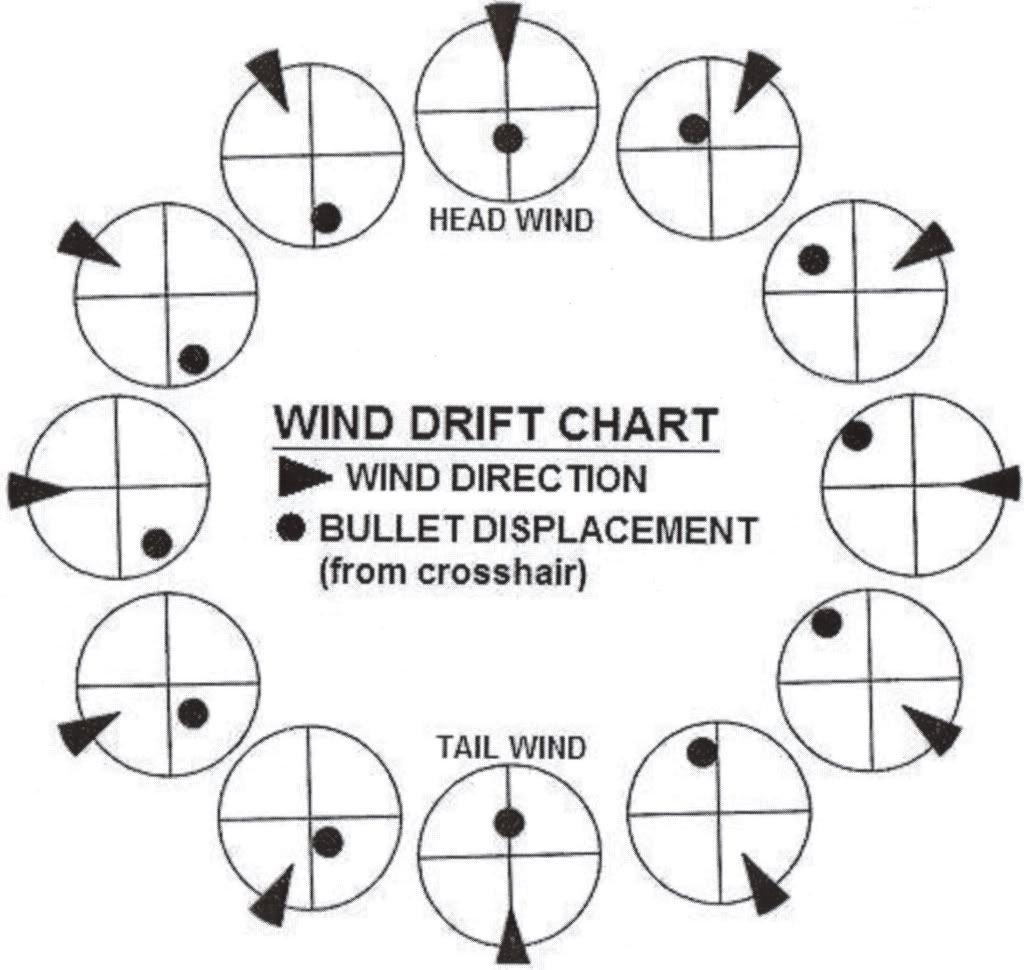The Accurate Reloading Forums
Effect of Tailwind on Ballistics
04 December 2011, 01:52
MJinesEffect of Tailwind on Ballistics
I am curious, if you have a load that shoots a 500 grain bullet at approximately 2100 fps and you are shooting in a strong tailwind, say 20-25 mph, what would the expected impact be on the bullet's velocity, if any, from the tailwind? Of course, I understand that cross wind will effect point of impact, but am curious what impact tailwinds have and how pronounced the impact would be. Thanks.
Mike
04 December 2011, 02:44
FOOBARTheoretically you would add the additional wind velocity...25mph = ~35fs...and theoretically there would be the cross sectional area of the base of the bullet that the wind acts on to consider...and theoretically the weight of the bullet/OD would have an effect as far as the BC is conserned...
Are you up on your Calculus?
But in reality the time of flight over the distance probably would negate any additional fs unless you are shooting very long distances...then you would have to define all the parameters like caliber, BC, distance, wind velocity, bullet initial/ending velocity, etc, etc, etc...gets pretty deep and esoteric.
Within probably 200 yds, whatever the additional fs impact, the variation in normal bullet velocity for several shots would negate any actual advantage average.
Short answer...yes it does impact, but only very little...now a couple hundred mph wind might...basically no different than a tail wind acting on an airplane...you have a moving volume of air enclosing a moving object...velocity, duration, size of both volumes, etc all have some kind of impact...how much...who knows...you need a fast computer to solve that equation.
Luck
04 December 2011, 04:30
D HumbargerI don't see how you would gain anny additional velocity because the bullet is moving at 2100 fps. Thats much faster than a 25~35 mph tailwind. 25 mph converted to fps... I don't know but i do know it is literaly at a snails pace.

Doug Humbarger
NRA Life member
Tonkin Gulf Yacht Club 72'73.
Yankee Station
Try to look unimportant. Your enemy might be low on ammo.
04 December 2011, 08:40
IndyYou don't gain any muzzle velocity but the bullet slows down less, so you gain velocity downrange.
For instance, if the bullet goes 2100 fps in still air, it sees a 2100 fps head wind. If you've got a 35 fps tail wind, it sees only a 1965 fps head wind (while still starting out at 2100fps) and doesn't see as much drag as it would with a 2100 fps head wind.
For any hunting situation where you would use a 2100 or even 3000 fps bullet, the effect of this slight difference can be ignored.
Indy
Life is short. Hunt hard.
04 December 2011, 08:57
FOOBARMuch better explainaiton, Indy. The question might be basic physics, or maybe better defined by Calculus, but the application can get a bit tricky when it comes to defining the total pieces and parts...many times what is going on is counter intuitive...and even harder to visualize.
The differential between the speeds is just too great to affect anything.
Luck
04 December 2011, 09:12
Art S.Here is a link to Sierra's writeup.
http://www.exteriorballistics....xplained/4th/531.cfm04 December 2011, 21:14
MJinesThanks for the input. I was curious since the load I was shooting seemed to be between 50-100 fps faster yesterday than when I previously shot the load and the temperature was roughly the same.
Mike
04 December 2011, 23:27
Bwana_500In theory, a tail wind will move a bullet's POI higher, and a head wind will move POI down. But physical features on the range will also affect POI. You see this on ranges with berms or holes or other undulations, where wind follows the contours and can cause a bullet to move in unexpected ways.
These effects get more pronounced the further from the muzzle the target is. I see this a lot shooting matches with a 6PPC, though at normal hunting ranges, particularly shooting offhand, I doubt you would see any measurable change in POI.
04 December 2011, 23:43
ZephyrWhen were tossing 175gr .308s about here is a chart that is applicable..... whether it applies to DG projectiles that is for some one else to pontificate on...

04 December 2011, 23:58
surestrikeSimply stated MV = Airspeed at which the bullet is traveling through the air.
If you have a headwind or a tailwind you add or subtract that value from the speed at which your bullet is traveling over the ground also known as ground speed or in bullet ballistic jargon Time of Flight (TOF). Air just like water is a fluid anything moving in that fluid will be affected by the movement of the fluid itself MV (airspeed) is unaffected in that fluid given a constant temperature,humidity and density altitude , ground speed (TOF)is always affected. Though it is a minor (insignificant) difference at any range that we would be shooting a DG cartridge.
05 December 2011, 03:41
Aglifterquote:
Originally posted by MJines:
Thanks for the input. I was curious since the load I was shooting seemed to be between 50-100 fps faster yesterday than when I previously shot the load and the temperature was roughly the same.
I think barometric pressure and humidity (Air density) can also affect burn rates, but I doubt there's enough of an effect to cause that much difference.
And for the support of this Declaration, with a firm reliance on the protection of divine Providence, we mutually pledge to each other our Lives, our Fortunes and our sacred Honor.
05 December 2011, 04:56
ZephyrUnderstanding Density Altitude is a key factor in long range shooting At a range of 1000 yrds I've seen as much as an 8 MOA difference in elevation using the same load and rifle on different days
05 December 2011, 06:10
RaySenderoquote:
Originally posted by Bwana_500:
In theory, a tail wind will move a bullet's POI higher, and a head wind will move POI down. .....
Bwana (& Zephyr too),
I've never tried to evaluate a tailwind vs a headwind for a CF rifle but I have on a 22LR.
For 22LR, a headwind will cause the shot to be higher at 50 yds.
Maybe a special case exception to the "theory"?
________
Ray
05 December 2011, 06:54
RobgunbuilderShooting into a tailwind you will get some additional lift of the bullet as a function of a lifting body. At 1000 yards it can be as much as 4 inches. At big bore ranges nada, none, zero effect.-Rob
Never underestimate the power of stupid people in large numbers to do incredibly stupid things- AH (1941)- Harry Reid (aka Smeagle) 2012
Nothing Up my sleeves but never without a plan and never ever without a surprise!
05 December 2011, 11:56
Bwana_500quote:
Originally posted by RaySendero:
Maybe a special case exception to the "theory"?
Ray
It is really not possible to give a definitive answer in a discussion such as this, no more than it is possible to say that if game is hit in the shoulder, it will collapse on the spot every time.
It is definitely possible for a head wind to move a bullet up or down from point of aim. But it is certainly not the case that it will always be moved higher on the target. On average, it will be lower on the target (relative to POI in zero wind). As I mentioned above, terrain between the muzzle and the target will have an affect on where the bullet goes on the target, so a bullet might be more or less likely to move in a given direction on a given range. The more accurate the rifle, the longer the distance to the target, and the more sturdy the shooting position, the more easily observable the effect will be.
I agree with Rob's point though, at the normal ranges that big bores are shot, and from field positions, the effect of most winds is a nonissue.
06 December 2011, 21:55
RaySenderoquote:
Originally posted by Bwana_500:
Ray
It is really not possible to give a definitive answer in a discussion such as this, no more than it is possible to say that if game is hit in the shoulder, it will collapse on the spot every time.
It is definitely possible for a head wind to move a bullet up or down from point of aim. But it is certainly not the case that it will always be moved higher on the target. .....
Bwana,
I was specifically refering to 22LR benchrest shooting - Headwind seems to consistently move POI higher. Very well could be a special case!?
________
Ray
06 December 2011, 23:11
Bwana_500quote:
Originally posted by RaySendero:
I was specifically refering to 22LR benchrest shooting - Headwind seems to consistently move POI higher. Very well could be a special case!?
Hi Ray
Sorry, I didnt quite get that statement from your original post. If you are suggesting that you have shot rimfire benchrest on multiple ranges, and always get a bullet moved high from point of aim on a headwind, then I must say I have not seen this. I have shot centrefire benchrest out to 1000 yards since the late 1990s and shot rimfire benchrest for several years through the mid 2000s. I cannot say that I have seen this type of consistency in a rimfire bullet’s behaviour in the wind.
However it would be relatively easy to get more data. I have several friends that shoot rimfire competitively at the national and international level. I will ask the question and see what we get from a cross section of competitive shooters.
07 December 2011, 14:06
HJ wildquote:
Originally posted by MJines:
Thanks for the input. I was curious since the load I was shooting seemed to be between 50-100 fps faster yesterday than when I previously shot the load and the temperature was roughly the same.
It
seemed to be 50-100 fps faster?? Did you measure it with a chrono?
Hans
08 December 2011, 03:35
Dutch44In my experience air currents are similar to the surface of a moving stream of water. The flow is never constant and the swirls and changing direction are exactly what happens in a tailwind (or any other wind direction for that matter). Typically, shooting with a tailwind is more difficult from an accuracy standpoint as the wind is not in a constant direction/speed. Seems to affect the forward/lateral direction of a projectile more so than a quartering or left/right wind affect. The above stated wind chart is only applicable if the wind is constant to both direction and speed, which is not generally the case.
Of course this has nothing to do with the speed of the projectile unless the shifting directions affects the momentum/velocity.
Dutch


